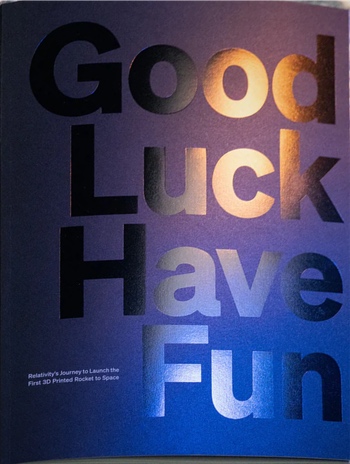Review: Good Luck Have Funby Jeff Foust
|
| “Terran 1 was the concept car. Terran R is the mass-market product,” Ellis states in the book. |
The book follows the growth of the company as it worked to mature its 3D-printing technology for producing large metal structures. It’s all about growth here: bigger printers, bigger facilities, a bigger workforce, and bigger funding rounds. Later on, we get to the rocket itself, Terran 1, and its Aeon methane-fueled engines. (The book states that Terran 1 was originally called Antoni 1, after architect Antoni Gaudí.) The vehicle’s printed structures and engines take shape and make it to the pad for its inaugural launch, all recounted in the book. The whole process, though launch, is lavishly illustrated in the book.
Because this book is from the company—the book has no author but acknowledges a couple dozen contributors, including Ellis—it is something of an advertorial product, a way to highlight what it has accomplished. The book does discuss technical setbacks it had along the way, such as difficulties with developing a flight termination system and engine test failures; one page includes a set of images from one such failed engine test, showing the engine exploding and destroying the thrust chamber and nozzle. But the reader is taken behind the scenes only as much as the company wants, rather than account from a third party that might offer a more critical view.
The book ends with Relativity’s future plans. Weeks after the “Good Luck Have Fun” launch, the company announced it was retiring the rocket so it could focus on the larger, reusable Terran R, a Falcon 9-class rocket expected to make its first launch as soon as 2026. “Terran 1 was the concept car. Terran R is the mass-market product,” Ellis states in the book. (The company had sold a number of those “concept cars” to customers ranging from Iridium to NASA before deciding to retire the vehicle.) Terran R, like Terran 1, will use 3D printing, although the company is turning to more traditional production methods for some components.
Good Luck Have Fun is marketed as something of a collector’s item, with only 500 copies available for purchase. It may not be the complete story of the development of Terran 1 and the early years of Relativity Space, but offers enough of a look to see why the company is pleased with what it has accomplished, even if they haven’t made it all the way to orbit yet.
Note: we are now moderating comments. There will be a delay in posting comments and no guarantee that all submitted comments will be posted.
